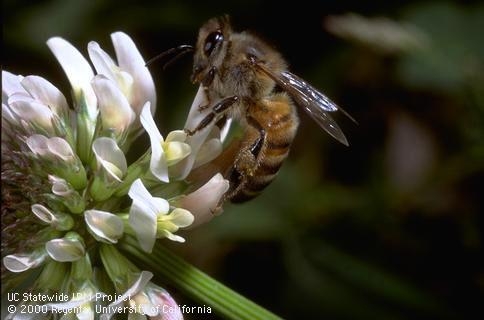Protect bees from pesticides by using bee precaution ratings from UC IPM
Our mission at the University of California Agricultural and Natural Resources (UC ANR), Statewide Integrated Pest Management Program (UC IPM) is to protect the environment by reducing risks caused by pest management practices. UC IPM developed Bee Precaution Pesticide Ratings to help pest managers make an informed decision about how to protect bees when choosing or applying pesticides. You can find and compare ratings for pesticide active ingredients including acaricides (miticides), bactericides, fungicides, herbicides and insecticides, and select the one that poses the least harm to bees.
Ratings fall into three categories. Red, or rated I, pesticides should not be applied or allowed to drift to plants that are flowering. Plants include the crop AND nearby weeds. Yellow, or rated II, pesticides should not be applied or allowed to drift to plants that are flowering, except when the application is made between sunset and midnight if allowed by the pesticide label and regulations. Finally, green, or rated III, pesticides have no bee precautions, except when required by the pesticide label or regulations. Pesticide users must follow the product directions for handling and use and take at least the minimum precautions required by the pesticide label and regulations.
A group of bee experts in California, Oregon and Washington worked with UC IPM to develop the Bee Precaution Pesticide Ratings. They reviewed studies published in scientific journals and summary reports from European and United States pesticide regulatory agencies. While the protection statements on the pesticide labels were taken into account when determining the ratings, it is important to stress that UC IPM's ratings are not the pollinator protection statements on the pesticide labels. In a number of cases, the ratings suggest a more protective action than the pesticide label.
The UC IPM ratings also include active ingredients that may not be registered in your state; please follow local regulations. In California, the suggested use of the Bee Precaution Pesticide Ratings is in conjunction with UC Pest Management Guidelines (for commercial agriculture) and Pest Notes (for gardeners). Each crop in the UC Pest Management Guidelines has a link to the Bee Precaution Pesticide Ratings database and provides guidance on how to reduce bee poisoning from pesticides.
For more information on protecting bees from pesticides, see UC IPM's Protecting Natural Enemies and Pollinators, and use the Bee Precaution Pesticide Ratings.



